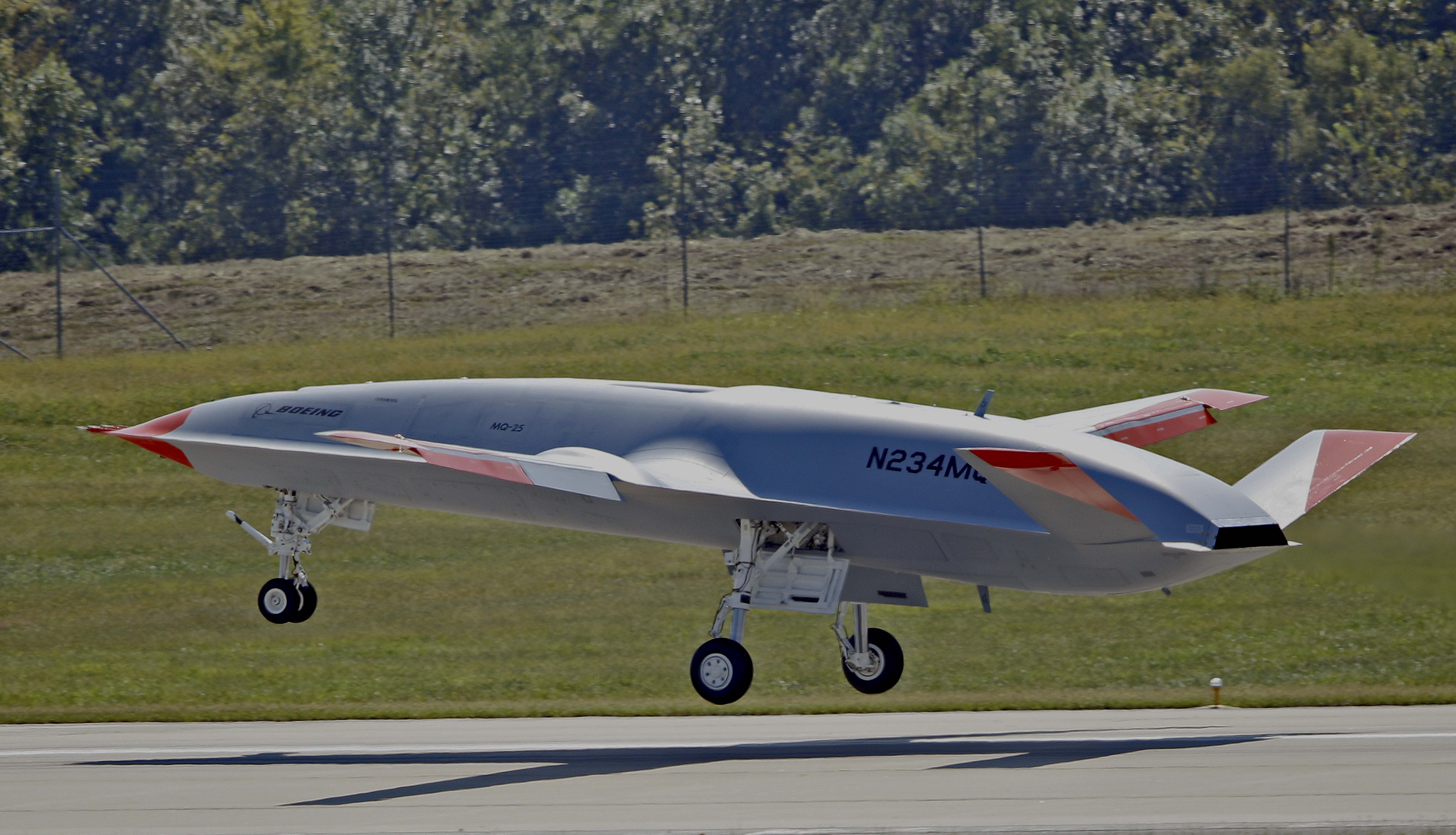
Boeing conducted the first flight of its prototype unmanned aerial refueling aircraft on Thursday, testing its handling and the Navy’s ability to fast-track a long-stalled program.
The MQ-25A Stingray “T1” test airframe flew for two hours, flying in and out of MidAmerica Airport, located next to Scott Air Force Base outside of St. Louis. Boeing and Navy officials described the weather as perfect for flying as the T1 gathered performance data for Boeing and the Navy to review.
“My objective in the program for a first flight was to have a what we call for testers a boring flight, and the testers were perfectly happy to oblige, and the aircraft performed exceptionally well,” Dave Bujold, Boeing’s MQ-25 program director, said during a media call Friday morning.
The T1 operates with a ground control station that was built to resemble what the control stations will look like aboard carriers, Bujold said. During the test, there were no surprises as the T1 flew on a pre-programmed flight path and handled as expected, including during takeoff and landing.
Boeing unveiled its first photos of the T1 in December 2017, and it has been at the MidAmerica airport since April.
Typically, when developing a new airframe, testing doesn’t start until the first engineering development models (EDM) are built. With the MQ-25 program, the first EDM airframes are expected to be ready for testing by the end of 2021, said Capt. Chad Reed, the Navy’s program manager for Unmanned Carrier Aviation (PMA-268), during the call.
The T1 test airframe offers the Navy and Boeing the ability to collect data two years faster than the typical test schedule, thus speeding the time required for the MQ-25A to reach initial operational capability.
The T1 lacks the refueling capability that’s a hallmark of the MQ-25A airframe, but the data collected now during the T1 test flights will provide Boeing and Navy testers with information about how the airframe operates in various weather conditions, altitudes and airspeeds. The plan is to hoist the T1 aboard a carrier to perform deck handling and ship-based control tests, Reed said. This data will help the Navy develop aerial refueling parameters before the first MQ-25As are built.
“It was a very exciting day for the Navy and the unmanned carrier aviation program,” Reed said. “It’s the first of what we anticipate will be many early learning opportunities helping us progress towards delivering a critical capability to the carrier air wing and also to the carrier strike group commanders.”
In 2021, when the first EDM airframes are ready, the T1 will yield to the first MQ-25As for testing. Reed expects the first EDM airframes test arrested landings and catapult launches from land-based systems by the end of 2021. In 2022 and 2023, MQ-25As will conduct carrier-based tests during sea trials, with 2024 as the target for the Navy declaring initial operational capability.
In 2018, Boeing beat out Lockheed Martin and General Atomics to land the $805-million contract to build the first four MQ-25As, in what has been for the Navy a more than decade-long, on-again, off-again lurch toward developing unmanned carrier-based tankers.
A fourth company, Northrop Grumman, had previously pulled out of the most current competition, though the firm had designed the X-47B UAV with similar capabilities in 2011. Northrop Grumman and the Navy performed carrier-based deck handling testing aboard USS Harry S. Truman (CVN-75) in late 2012. The X-47B also performed arrested landings at Patuxent River, USNI News reported in 2013.
Now, nearly a decade later, Boeing plans to run similar tests with the T1 aircraft, starting with deck handling tests in 2020 and arrested landing at Patuxent River in late 2021, after the first MQ-25A is built.
The Navy’s mission for carrier-based UAVs has evolved during the past decade. Initially, the UAVs were considered to augment a carrier-based strike capability and to provide surveillance missions. Instead, the Navy narrowed its focus to refueling as a way to free up more F/A-18E/F Super Hornets for strike missions.
“Stingrays can provide persistent aerial refueling that’s going to extend the range and operational capability of the carrier air wing and the CSG, and it’s going to improve the efficiency by increasing the number of F-18s available for the strike fighter mission,” Reed said.
Currently, between 20 and 30 percent of an air wing’s Super Hornet fleet is dedicated to aerial refueling operations. The introduction of the MQ-25A Stingray will free up those Super Hornets for strike missions. The MQ-25A will delivery up to 15,000 pounds of fuel at 500 nautical miles.
Developing the MQ-25, Reed said, will “provide a vital tanking capability but also pioneer the integration of manned and unmanned platforms for the future carrier air wing.”





